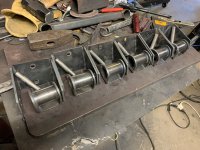Alrighty folks, another 12 months have passed and I still haven't used a set of these.. I did send off a set to a guy, but hasn't needed them yet either..
Luckily I had a small fire under my took-us created by these guys,
https://www.fordsix.com/threads/worries-about-hitting-carb-touching-shock-tower.72974/ - fixed link
So after a lot of other life delays, I finally got 2 full sets created, finished, and painted.
And here are some build pics.
Cut some new plates
The other brackets in this picture which are NOT small six motor mount brackets are as follows from left to right
Small Six Engine lift bracket (bolts to rear passenger side of some heads that have throttle linkage pads)
The BIG bracket is a Ford 240/300 lift bracket that bolts onto the intake/exhaust bolts.
The small one on the top right is a single hole lift bracket, originally designed to be used on a Ford 240/300, but I suppose it could be used anywhere..
Then the bottom brackets are the ones to be used in building small six motor mounts.

For those that don't know, plasma cutting leaves a little 'blow out' or slag on the bottom side when its done. These plates are fresh from the CNC table, no grinding has been done on them yet.
Small bracket
Front Side

Back Side
(bolts to frame bracket)

Big Bracket
(bolts to engine)
Front

Back

This time I was lucky enough that the CNC Brake press operator at work bent the big brackets for me

For the small brackets, I was not so fortunate, so I used my home made press brake jig

This is the backside of the small bracket after the plasma slag has been ground off

The downside to the small bracket is that I had the large holes cut to be almost exactly the same diameter as the tubing that I want to put through the hole.
In every case I have had to use some sort of die grinder to open up the hole after I had bent he bracket. This is mostly because the hole edge closest to the bend is deformed slightly during the bending process.
Luckily I had a small fire under my took-us created by these guys,
https://www.fordsix.com/threads/worries-about-hitting-carb-touching-shock-tower.72974/ - fixed link
So after a lot of other life delays, I finally got 2 full sets created, finished, and painted.
And here are some build pics.
Cut some new plates
The other brackets in this picture which are NOT small six motor mount brackets are as follows from left to right
Small Six Engine lift bracket (bolts to rear passenger side of some heads that have throttle linkage pads)
The BIG bracket is a Ford 240/300 lift bracket that bolts onto the intake/exhaust bolts.
The small one on the top right is a single hole lift bracket, originally designed to be used on a Ford 240/300, but I suppose it could be used anywhere..
Then the bottom brackets are the ones to be used in building small six motor mounts.

For those that don't know, plasma cutting leaves a little 'blow out' or slag on the bottom side when its done. These plates are fresh from the CNC table, no grinding has been done on them yet.
Small bracket
Front Side

Back Side
(bolts to frame bracket)

Big Bracket
(bolts to engine)
Front

Back

This time I was lucky enough that the CNC Brake press operator at work bent the big brackets for me

For the small brackets, I was not so fortunate, so I used my home made press brake jig

This is the backside of the small bracket after the plasma slag has been ground off

The downside to the small bracket is that I had the large holes cut to be almost exactly the same diameter as the tubing that I want to put through the hole.
In every case I have had to use some sort of die grinder to open up the hole after I had bent he bracket. This is mostly because the hole edge closest to the bend is deformed slightly during the bending process.
Last edited by a moderator:





















